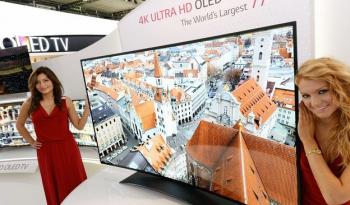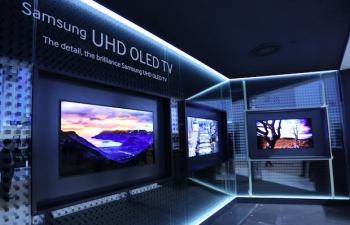Last month I posted about the new wave of UHD (4K) TVs. 4K resolution usually means 3840x2160 and offers four times the pixels of FHD (hence the 4K name). In my post I quoted DisplayMate's Raymond Soneira that said a human being can't really tell the difference between 4K and FHD panel in a 55" TV viewed from a normal viewing distance.
 LG UHD OLED TV prototype
LG UHD OLED TV prototype
This sparkled a lively debate. Some people say that 4K images are superb to Full-HD ones. Only today Paul Gray, DisplaySearch's director for EU TV research posted his thoughts on the IFA exhibition - and he says 4K provides a completely new way of viewing and enables immersion even better than 3D.
 Samsung UHD OLED prototype
Samsung UHD OLED prototype
I asked Raymond to respond. So first of all, he says that actual precise measurement of the human eye's sharpness cannot be achieved because the sharphness does not have a "hard limit" - it is a point of strongly diminishing returns. He agrees that under ideal conditions, someone with perfect (20/20) vision will be able to see a small improvement in sharpness above the resolution limit discussed before. But that is under ideal conditions - peak white to pure black pixel-on/pixel-off test patterns viewed in absolute darkness on very high contrast displays.
In real world ambient light viewing conditions the contrast ratio falls significantly, and therefore so does visual sharpness and modulation transfer. You're welcome to read Raymond's ambient light article here. In addition, real TV conent (photos, videos) are inherently fuzzy because the image detail is spread over multiple pixels. So a sharpness difference is even less likely to be detected by a human eye (this is especially true with jpeg images). In movies that are continually changing, a fair amount of image detail is often visually lost due to its transitory nature, plus digital mpeg compression that reduces image detail and sharpness.
So I guess the debate will continue. On one side we have reviewers and consumers saying that image quality is superb. On the other side we have physics saying this is impossible. It may be that UHD content shown in exhibitions and in demonstrations are static images without compression - and these really look better in 4K resolution - especially of course as you tend to look closer at the screen in exhibitions and demos than you'd do back home.
Regarding OLED vs UHD, it seems that this specific competition isn't real. During IFA both Samsung and LG unveiled UHD OLEDs (and Sony and Panasonic's own 4K OLED prototypes were shown earlier this year) and it seems that future OLED panels will indeed support the higher resolution whether it makes sense or not.
Comments
"4K" means 4-thousand-pixels and is related correctly to 4 x 1024 pixels which is 4096 px since "k" means 'kilo' thousand, like 4 KB means 4 Kilo Bytes - 4 thousand bytes - . This resolution is used in professional cinema cameras (like RED) that have 4096 x 2160px+ resolution, hence the 4K name. When it comes to 16-9 screens they have 3840 px, so the name Ultra HD is more adequate since this is not really 4K resolution. Cheers.
I disagree.. What do I need a smart TV for? When I watch tv I want to watch movies or sport games in the best possible way, the closest possible to Cinema or Stadium, hence I want the picture qualiy to be at its best, I'm willing to have 4K (better quality, same as Cinema cameras and more advanced projectors), OLED (more contrast), 3D and so on.. If I want something "smart" I go for a PC, tablet, phone, eventually I use bluetooth, NFC or HDMI/Usb to transfer to the TV if I need the big screen... If only thing a tv does is going on the net, then they should stop calling it tv and go for Super-size tablet...
3D commercial failure? if anybody desynchronise the reality of its release in 2010 , everyone in the world will understand that, THERE WAS NO 3D CONTENT! , nobody is buying a brand new television for $2000 + to watch 3D movies/games free to air channels if it is non exsisttent.
Would anyone buy a Xbox One or a Playstation 4 for $2000 if there was not a single game on the system , no.
Right now today 2013 december , whats currently availible to watch on 3D blu ray is what should have been offered ready for the release of 3Dtv's they just tried to capitalise on the momentum of say, Avatar. This had to be explained regardless of anyone's interest or not, its just the logical truth prehaps this conclusion with result in an epiphany for some.
There is a current and future use for the 55" Vision screen. Educational purposes. The new immersive technology could teach our children natural sciences and universal studies much faster than traditional classroom study. The initial view from the "Vision Screens" (I made that up to describe the whole technology entailed) would spark curiosity. Then the classroom study would require investigation and research. There is already scientific study being done on how much faster the brain is registering and processing information in an Immersive, nearly VR , environment.


Well seeing how current 3D technology is by now mostly viewed as a commercial failure the guys who want to sell 4K UHD better hope that it enables better immersion than 3D...
Personally I still think the display industry is going the wrong way with this and instead should focus more on a really well usable Smart TV.